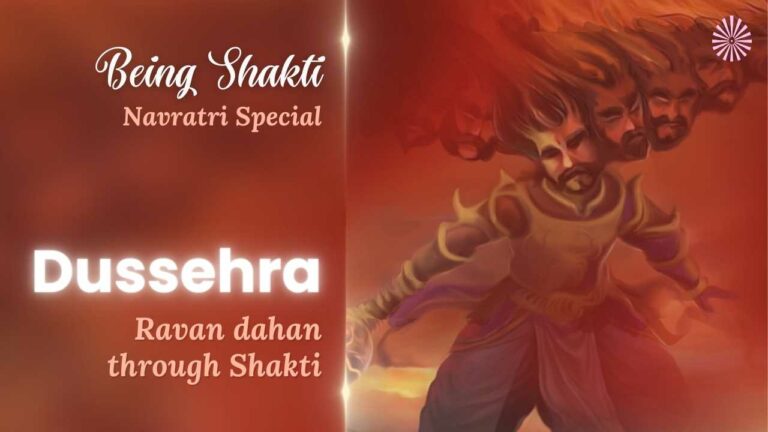
Ram Rajya Bharat – The Call Of Time
Article discusses transition from ‘Ravan Rajya’ to ‘Ram Rajya’ through shifting consciousness, personal transformation for societal change.
Before we begin any auspicious task, we lovingly invoke Ganesh ji and hail him as the destroyer of obstacles, wiper of sorrows, and bestower of happiness. Once we understand the significance behind his birth, form and qualities, it becomes easy to realise that we must not just praise him but must endeavour to imbibe his qualities and powers into our own life.
It is said that Shankar ji had gone to the far off mountains to meditate. One day Parvati ji wanted someone to guard the gate when she wished to bathe. So she created a child from out of the dust on her body, breathed life into him and instructed him to stand guard. Unexpectedly that day, Shankar ji returned home from an intense meditation of 10 years, but the child denied him entry as he did not recognise his own father. It is said that Shankar ji was so annoyed that he cut off the child’s head. Parvati ji who came out and saw the scene grieved that Shankar ji had beheaded his own son. Shankar ji then assured her, “Whoever will pass by our home next, I shall cut his head and affix it to our son’s torso.” It was an elephant that passed by their home. Shankar ji cut that elephant’s head, fixed it to the boy’s torso and named him Ganesh.
Although it is an interesting story, we need to pause and question the flow of certain events in it.
Introspecting on the essence behind the story, shows that answers to the above questions are relevant to our own life. What is the story teaching us? Let us understand.
If we observe every part of Ganesh’s body, every aspect teaches us the right way to live; it also teaches how to inculcate spiritual wisdom in our daily life:
Secondly, a mouse can enter our homes even through an extremely tiny hole. Likewise our vices, weaknesses and distractions come into our life without our awareness. When a mouse is about to bite someone, it first creates an anaesthetic effect on our body so we don’t realise the mouse bite immediately. Likewise, when our vices and distractions attack us, we don’t even realise their harm immediately. But the pain starts much later. When we broaden our wisdom, develop farsightedness, we use ears to listen only pure information, we speak less, speak soft, speak powerful words, we keep things to ourselves, we walk the path of discipline of wisdom, we finish our vices using the axe of wisdom, we bless everybody, we remain humble and not become egoistic; when we do all this, we will gain victory over our sense organs and vices. The one who wins over his mind automatically wins over his world. This is why Ganesh ji is shown sitting on top of the mouse. The mouse is subservient to him (below him).
There is another beautiful story in which Ganesh ji and his brother were once asked to go around the universe. His brother Karthikey ji started to walk around the whole world. But Ganesh ji just went around his parents once. This reminds us that today we are working hard for happiness, health, relationships, and career. But if we connect to our Supreme Parent God, then our every karma will be accurate. Happiness, health, harmony in relationships, success and a beautiful world will come naturally.
Thus Ganesh ji teaches us to lead a life like him. Any one who does all these things is said to be Vighna- Vinashaka (Destroyer of obstacles); obstacles cannot enter his life, they get destroyed even before entering. Such people will be so powerful that they don’t just destroy the obstacles in their life, but also destroy the sorrow in others’ life and bestow them with happiness. When we start experiencing and expressing the divine qualities as symbolised by Ganesh ji in our every thought, word and action, our obstacles get destroyed. We enjoy a life filled with divinity and prosperity.
Lord Ganesh is a revered deity in Hinduism, known for his distinctive appearance with an elephant head and human body. He is celebrated as the remover of obstacles, the patron of wisdom and intellect, and the bestower of happiness and success. His birth story, often referred to as the legend of Ganesha’s birth, carries immense spiritual significance and serves as a source of inspiration for devotees.
The story of Lord Ganesh’s birth imparts several profound lessons. Firstly, it highlights the symbolic significance of the elements involved. The notion of creating a child from dirt on the body signifies that our physical existence is transient, and our true essence is spiritual. The child’s failure to recognize his father, Lord Shiva, symbolizes how our ego and material consciousness often blind us to the presence of the divine. Lord Shiva’s act of beheading and then replacing the child’s head signifies the necessity of transcending ego and embracing wisdom and divinity to overcome obstacles.
Lord Ganesh’s distinctive appearance is rich in symbolism. His large forehead represents wisdom and a broad intellect. His tiny eyes signify farsightedness, encouraging us to foresee the consequences of our actions. His small mouth reminds us to use words sparingly and constructively, blessing ourselves and others. His broad ears, shaped like filters, teach us to listen more and absorb only pure and positive information. The presence of two tusks, one broken, symbolizes the elimination of dualities and the pursuit of stability in all aspects of life.
Lord Ganesh’s posture teaches us valuable life lessons. His seated position with one leg touching the ground and the other folded signifies the need to balance engagement with the world while remaining emotionally detached. This stance encourages humility and stability, reminding us not to let external factors sway our inner state of mind.
Lord Ganesh’s association with a mouse carries a symbolic message. The mouse represents our sense organs and distractions, symbolizing our vulnerability to external influences. Lord Ganesh’s mastery over the mouse signifies the importance of self-control and victory over our sense organs and vices. By riding atop the mouse, he establishes dominion over these distractions.
The presence of Riddhi and Siddhi, depicted as Lord Ganesh’s consorts, signifies that by embodying Lord Ganesh’s divine qualities, individuals naturally attract prosperity and success. It emphasizes that one need not chase after external achievements but should focus on inner transformation and virtuous living.
To apply Lord Ganesh’s teachings, one can start by internalizing the virtues and qualities symbolized by his form. This includes embracing wisdom, speaking thoughtfully, listening attentively, practicing humility, and maintaining emotional balance. By imbibing these qualities in daily life, individuals can overcome obstacles, experience spiritual growth, and enjoy prosperity and happiness. Lord Ganesh’s teachings serve as a guide for leading a harmonious and fulfilling life.

Article discusses transition from ‘Ravan Rajya’ to ‘Ram Rajya’ through shifting consciousness, personal transformation for societal change.

Discover the profound spiritual essence of Mahashivratri, exploring the significance of awakening, fasting, and the symbolic consumption of bhang, guiding us towards a golden dawn of purity and peace

Life is like a big play, and sometimes we forget who we really are. We get caught up thinking our bodies are everything. But there’s a different kind of TV—the one in our minds—that shows us how to be better and happier. Instead, we often watch a different channel, filled with stress and bad habits, making us forget about the good stuff. Tuning into the better channel helps us learn and grow, making us stronger on the inside.

This blog emphasizes the importance of internal transformation in the New Year, advocating for a shift from external goals to fostering inner peace and empowerment. It underscores the power of not absorbing negativity, instead radiating positivity and using visualization techniques. The central theme is about evolving into an angelic presence, offering strength and positivity to oneself and others.

Living a life filled with actions aiming for personal, professional, social, or financial success is common. However, when ambition turns into an obsession, affecting mental health, relationships, and well-being, it can lead to pitfalls.

This piece explores how simple things like Christmas decorations can become beautiful and bring joy, just like we can change and find happiness within ourselves. It says that when we take care of ourselves and grow inside, it’s like making something pretty. It’s like decorating a tree – we should fill our lives with happiness and love instead of feeling sad or fake. And it shows how changing our inside (the soul) can make us happier and help us spread love to others, even when times are tough during the holidays.

The Christmas tree, lights, and Santa Claus symbolise the unity of souls and God’s presence across time. Each leaf on the tree represents our uniqueness as souls while belonging to one divine family. Santa’s arrival signifies God’s appearance during dark times, offering spiritual gifts of love and virtues, echoing Christ’s teachings of unity and compassion, urging us to connect with our spiritual essence amidst the festive celebrations.

In today’s world, Christmas signifies both the end of one year and the beginning of another, prompting various preparations and reflections. Beyond the festivity, its true significance lies in the arrival of Christ, signifying a shift in the calendar and a profound spiritual transformation. Christ symbolises the triumph of virtues over vices, advocating for love and humility in a world now plagued by fear and arrogance. The commercialised “Santa Claus” tale might conceal a deeper message, hinting at the arrival of divinity during times of moral decline.

पुरुषार्थ या योग से हमारे संकल्पों में परिवर्तन आता है। संकल्प से फिर कर्मों में बदलाव आता है और फिर संस्कारों में फेर-बदल होता है। अतः ‘योगी तू आत्मा’ बनकर अपने संकल्प शक्ति को सही दिशा दें, जिससे इस नए साल में स्वयं के तथा विश्व के कल्याण में महत्वपूर्ण भूमिका निभा पाएं।

Dussehra’s lesson is that, like Lord Ram facing the never-ending emergence of new heads when he struck one down, we must focus on eradicating the root of all our vices I,e Body consciousness by practising Meditation and Spiritual Knowledge.
Start your day with a breeze of positivity and stay motivated with these daily affirmations
After Clicking on Join, You will be redirected to Whatsapp Community to receive daily message. Your identitiy will be secured and no group member will know about another group member who have joined.